#Armenian palestinians
Text
Armenians have lived in Jerusalem for 1,600 years and Armenian Palestinians are the oldest group in the Armenian diaspora. From their indigenous land in Artsakh to the Armenian Quarter in Jerusalem, Armenians have been facing ethnic cleansing and persecution on multiple fronts. With the escalating genocidal violence in Gaza and the West Bank, armed settler encroachment into Armenian holdings in Jerusalem has fallen under the radar of some pro-Palestine activism and it is critical we do not allow this to happen.
Some context:
( In 1948, Armenians in Jerusalem numbered about 16,000. Today, that number has shrunk; estimates range from 700-1000, with a smaller community in Bethlehem. )
“We are not the objectives of the Israelis, but we occupy a huge chunk of Jerusalem. The fact that we’re here is an obstacle for them, but we’ve been here for 1,600 years and we’re not going anywhere.”
"These are only the most visible of the challenges facing the community....Israeli discrimination, economic decline, and political insecurity have taken a toll on Armenians, encouraging emigration.
A century after the community was nearly annihilated, Armenian Palestinians today say they feel deeply at home in the Holy Land, but fear how much longer they will be able to hold on."
“Don’t ask me about the massacres that happened 100 years ago [1915],” Annie Guluzian said when asked about her experiences as an Armenian Palestinian. “I won’t open [up about] those topics. Because if I do, I will start talking about my brother who was martyred by the Israelis in the [second] Intifada.”
The toll of the Israeli occupation in Palestine is what defines her life today, Guluzian added. Source
Since October 26th, 2023, when the leader of the Armenian Patriarchate of Jerusalem announced it would cancel a once-secret 2021 land lease deal with a real estate company that has alleged links to settler interests, the company, Xana Gardens, has sent in armed settlers and bulldozers to steal the land (including Armenian Chruch property and several Armenian families). Armenians have been resisting the occupational forces day in and day out.
From November 5th:
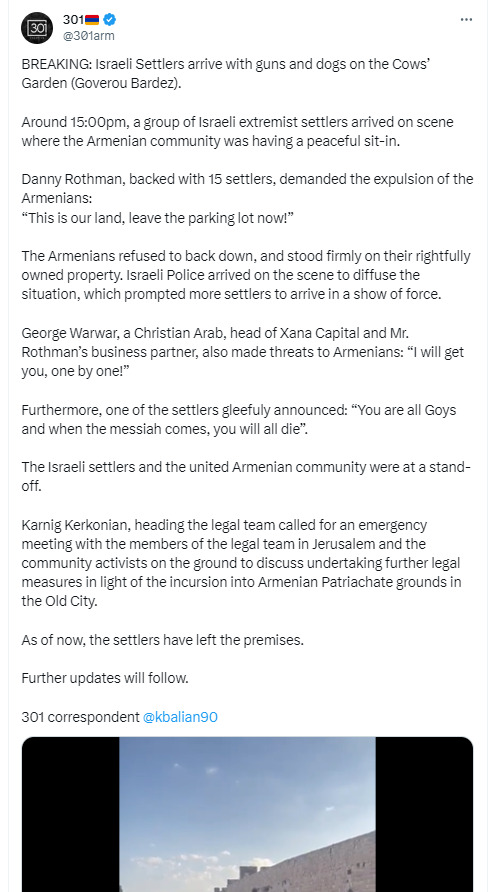
Link to tweet and video
November 5th:

Link to tweet and video
November 22nd:

Link to tweet and thread
November 25th:

Link to tweet and thread
In response, Armenians have created an account on Twitter called SaveTheArq which has been documenting and updating on social media the recent land demolitions by Israeli settlers in the Armenian quarter, they have also launched a fundraiser for legal actions to protect the Armenian quarter and I highly recommend donating, if you can't, please share it around:
#palestine#jerusalem#armenia#armenian diaspora#save the Armenian quarter#free palestine#my liberation as a Palestinian is not complete without the liberation of Armenians and I stand by that#Armenian palestinians#armenian genocide
7K notes
·
View notes
Text


[left: Anam is 90 years old. She lived through the Nakba in 1948, and today she was displaced again from the city to the south of the Gaza Strip.]
via ig: belalkh
[right: Amalia born in Martakert, Artsakh in 1920. Older than the borders of her region. She has experienced genocide all her life. She is now a refugee.]
via ig: stufankjian
#armenia#palestine#freepalestine#free artsakh#Gaza#Artsakh#🍉#west asia#middle east#armenian#Palestinian#nabka#genocide#armenian genocide#armenian palestinian solidarity
4K notes
·
View notes
Text
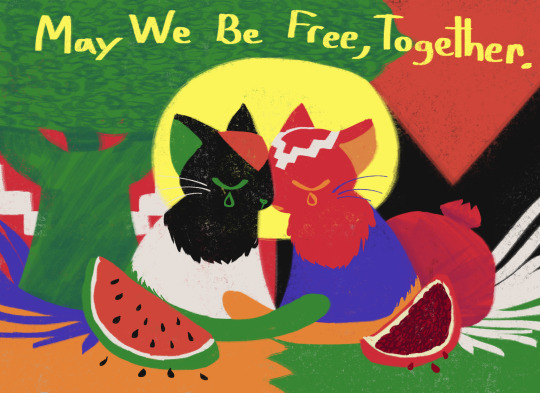
🇵🇸 May We Be Free, Together. One genocided peoples to another. We stand with Palestine, now and forever. 🇦🇲
Care for Gaza (Direct Paypal)
E-Sims for Gaza (Showing Where/How to give them)
Palestine Children Relief Fund
Medical Aid for Palestinians
Daily Click For Palestine (Help by at least clicking this daily, it may not be much but it counts for something at least.)
BDS's website, remember to follow the boycott.
#free palestine. never stop talking about it. do everything you can. something is better than nothing.#cannot put neatly into words how much i feel for palestine. how much is influenced by being armenian as well.#and what ive learnt. both from online and from my mother. its a lot. its a lot.#i will never get over the poem Who remembers the armenians by a Palestinian author.#we remember you . we do too. you remember us. we remember you. ah...#my art#i dont.. try making art of my feelings. often. rarely. but. i try now. i try.
1K notes
·
View notes
Text

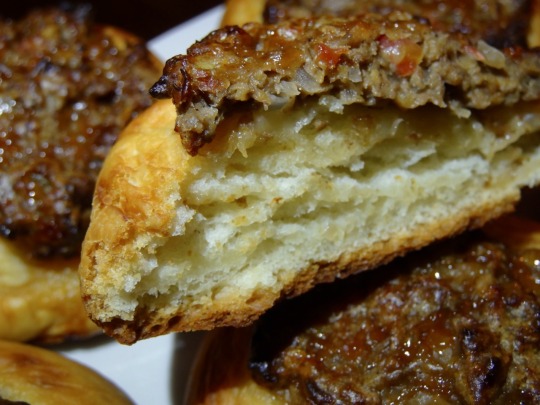
[ID: First image is a close-up on a plate of small flatbreads topped with ground ‘meat’; second is a cross-section of one of the breads. End ID]
صفيحة فلسطينية / Safiha falastinia (Palestinian topped flatbread)
Etymology and origins
صَفِيحَة (“ṣafīḥa”), also transliterated “sfiha” and “sfeeha,” is a flatbread eaten in Palestine, Lebanon, and Syria, comprising a yeasted dough topped with a filling made from ground lamb or beef, spices, and chopped aromatics and vegetables. It may also be called “اللَحْم بالعَجِين” (“al-laḥm b al-‘ajīn,” “meat with dough”)—this phrase is the source of the Turkish “lahmacun” and the Armenian “Լահմաջո” (“lahmadjo”), which describe a closely related dish.
The word “صَفِيحَة” literally means “thin plate” or “sheet”; it comes from the root ص ف ح (ṣ f ḥ), which produces words related to flatness. Compare for example “صَفَّحَ” (“ṣaffaḥa”) “to flatten,” “صَفْحَة” (“ṣafḥa”) “page,” and “صَافَحَ” (“ṣāfaḥa”) “to shake hands.”
In English, lahmacun (also transliterated "lahmajoun") is sometimes called "Armenian pizza." Similarly, it may be called "صفيحة الأرمنية" ("safiha al-'armaniyya"), "Armenian safiha," in Palestine, indicating that it is regarded as a borrowing from the local Armenian immigrant community. In Armenia, lahmadjo is a very thin, soft flatbread typically topped with beef or lamb, tomatoes, tomato paste, bell peppers, onion, garlic, parsley, red chili paste, and black pepper. With Palestinian safiha, lamb is the typical choice of meat; the dough may be thicker, and enriched with the addition of milk, milk powder, or yoghurt; bell peppers are ommitted; and fried pine nuts may be added. Palestinian restaurateur Nassar Odeh remembers lahmadjo being served in Jerusalem's Old City decades ago; he says that "Armenian dishes" such as this have become "part of the Palestinian culture."
Though the Arabic-derived "lahmadjo" and related terms may be heard, [1] the most common Armenian-language name for this dish is "լոշմիս" ("loshmis")—presumably from "լոշ" "losh" "lavash, thin bread" + "միս" "mis" "meat." Some Western Armenian variations on the name reverse this order (meat-dough, rather than dough-meat): "մսաշոթ" ("msashot"), from "մսա" "msa" "meat" + "շոթ" "shot" "thin bread"; and "մսալոշ" ("msalosh"), from "մսա" "msa" "meat" + "լոշ" "losh" "thin bread."
The dish
A common part of everyday Palestinian cooking, صَفَائِح ("ṣafā'iḥ"; plural of "ṣafīḥa") are often eaten as a snack or a portable lunch. They may also be served as a مَزَّة ("mazza"; "appetizer") for عِيد ("'īd"; "feast," "holiday"; often transliterated "Eid") or Christmas.
Safa'ih are shaped into pinwheels in the port city of يَافَا ("Yāfā"; often transliterated "Yaffa" or "Jaffa"), stuffed with ground meat or spinach. In the Bethlehem region the topping is often mixed with tahina, as well as vinegar or lemon juice, and perhaps pomegranate molasses. Other versions of the meat topping omit tahina and vinegar, and are more tomato-heavy instead.
This recipe is for Bethlehem mazza-style safa'ih, with thick crust that's crisp on the outside and light and fluffy on the inside. Vinegar and pomegranate molasses provide a bright, slightly fruity lift to the topping, while tahina grounds it with a toasty, nutty aroma. Black pepper, allspice, and a green chili pepper add complexity and heat.
[1] There is a proliferation of possible spellings for "lahmadjo" in Armenian, which would indicate that it is a loanword (probably via Turkish, ultimately from Arabic). These spellings include "լամաջո" ("lamadjo") [common]; "լահմաջո" ("lahmadjo"); "լահմաջու" ("lahmadjou"); "լահմաջոն" ("lahmadjon"); "լահմաջուն" ("lahmadjoun") [literary; uncommon]; "լահմաջին" ("lahmadjīn"); and "լահմաջի" ("lahmadjī") [rare]. The letter "ջ" is pronounced as "dj" (IPA: [d͡ʒ]) in Eastern Armenian and a "tch" (IPA: [t͡ʃʰ]) in Western Armenian (timestamp: 40:33).
Support Palestinian resistance by donating to Palestine Action’s bail fund; buying an e-sim for distribution in Gaza; or donating to help a family leave Gaza.
Ingredients:
Makes 24 small safa'ih. Serves 24 as an appetizer, or 6-7 as a main dish.
For the dough:
5 cups (600g) white flour
A cup (230g) non-dairy yoghurt (لبن رائب) (I used soy)
1/2 cup (125 ml) olive oil
1 1/2 Tbsp (15g) dry yeast
1/2 Tbsp (4g) kosher salt
1 tsp (5g) sugar
A scant cup (220g) of water
A more "everyday" preparation of this dish might make larger, flatter safa'ih out of a dough without dairy. This holiday variant includes yoghurt and makes smaller, fluffier safa'ih; but the yoghurt may be omitted (or milk or milk powder may be added) without injury, and the flatbreads can be made any shape you like.
Leila al-Haddad writes that, in Gaza, white flour used to be eaten as a treat and for special occasions before it later came to replace whole wheat white flour in many kitchens.
For the topping:
500g ground beef substitute (as a replacement for minced lamb)
1 medium tomato, minced
1 medium onion, minced
1-2 green chili peppers, minced
2 tsp kosher salt (1 tsp table salt)
3/4 tsp black pepper
3/4 tsp allspice; or Palestinian 7-spice / mixed spices (بهار مشكل)
1/4 cup white tahina
2 Tbsp pomegranate molasses
2 Tbsp white vinegar, or lemon juice
For a tomato filling, omit the tahina and vinegar, and instead use 2 Tbsp tomato paste; or 8 diced or puréed tomatoes, cooked down.
Instructions:
For the dough:
1. Combine all dry ingredients in a large mixing bowl.
2. Make a well in the center and add in the yoghurt, olive oil, and water. Mix them together and then combine them with the rest of the dough. Add water or flour as needed to obtain a soft, slightly tacky dough.
3. Knead the dough on a clean surface for 5-10 minutes, until it bounces back when pressed. Allow to rise, covered, in an oiled bowl for 1-2 hours, until doubled in size.
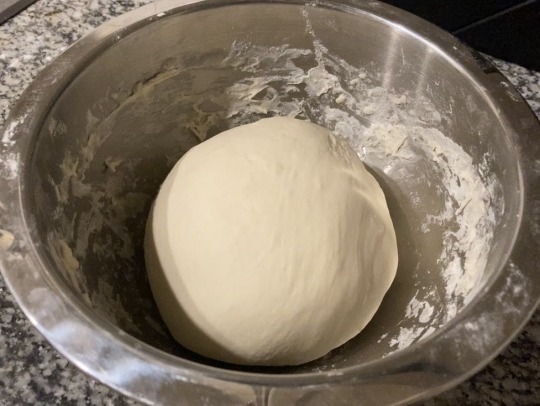
For the filling:
1. Mince vegetables, or run them through a food processor. Mix all filling ingredients together.
To assemble:
1. Divide dough in half, and then half again; roll out each quarter of the dough into a cylinder and cut it into six equal pieces.
2. Roll each piece of dough into a ball between your hands, and then flatten it into a disc about 1” (2 1/2 cm) high and 3” (8cm) wide. Place on a baking sheet prepared with parchment paper, leaving an inch of space between each circle.
3. Press the center of each dough circle down slightly to create a crust around the edge. Add a few spoonfuls of filling to the center of each safiha and press flat.

4. Bake safa'ih in the middle of an oven at 450 °F (230 °F) for 25-30 minutes, until crust is golden brown.
Serve as an appetizer alongside vegetable salads, pickles, olives, &c.
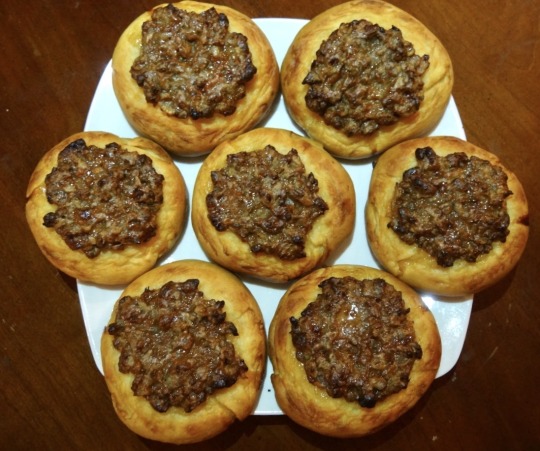
378 notes
·
View notes
Text
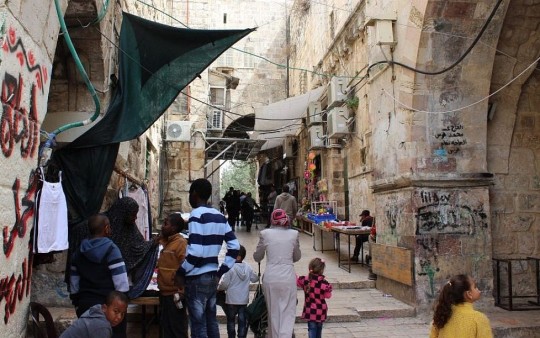
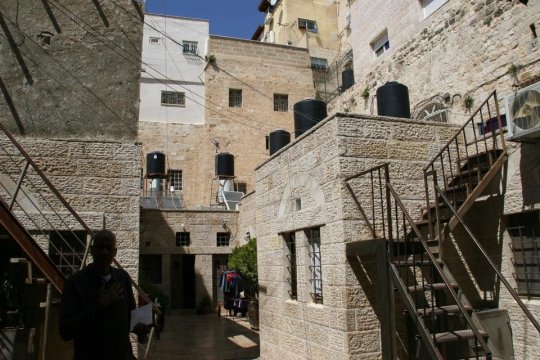
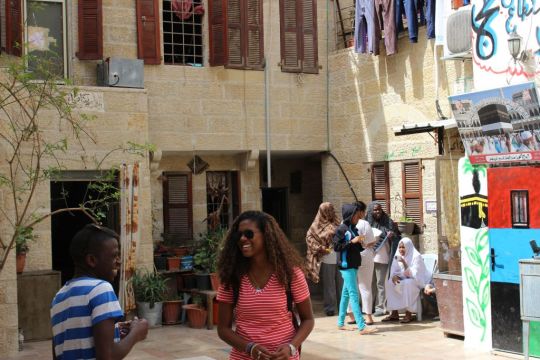
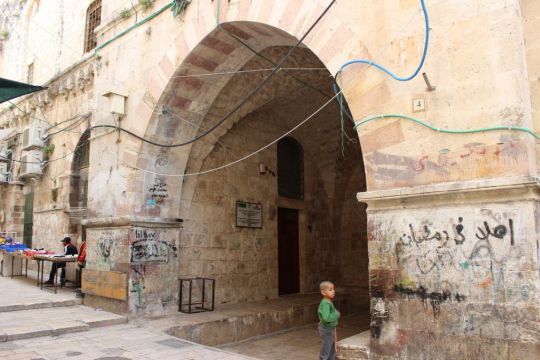
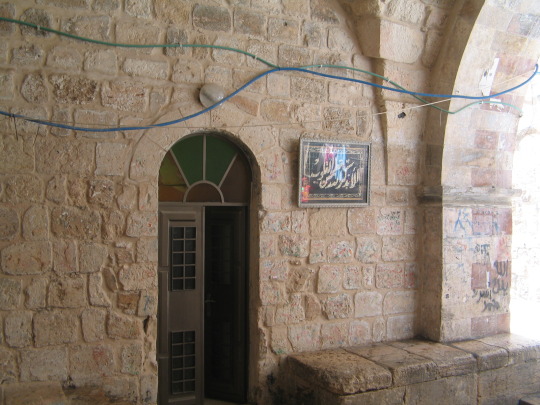
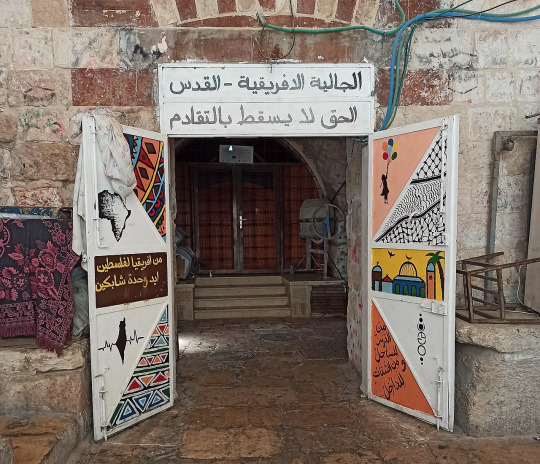
pictures from the old city of jerusalem's "african quarter", which comprises of ribat al-mansuri and ribat al-basiri. mamluks built the compounds in the late 13th century to house muslim pilgrims and the poor. ottomans used them as prisons, and the british closed the prisons when they occupied jerusalem in 1917. the ribats then came under the ownership of the islamic waqf, and were leased to the local afro-palestinian community.
afro-palestinians have an array of origins. like some other diaspora communities in palestine, some came through pilgrimage - al-aqsa was on their hajj path, and while many would visit to pray there, some decided to settle in jerusalem. there are also some who came to palestine enslaved or conscripted, most recently to ottomans. some came during the time of the british mandate, many as conscripted laborers to the british. afro-palestinians who can trace their ancestry do so to nigeria, chad, senegal, or sudan.
jerusalemite afro-palestinians were employed to guard al-aqsa throughout the ottoman period. during the 1948 palestine war, some joined the arab liberation army and fought with fellow palestinians to defend al-aqsa and their presence in jerusalem. the position of guards has been taken by occupation soldiers since the 1967 war, after which a quarter of the afro-palestinian population became refugees in surrounding countries.
jerusalem's afro-palestinian community still live in the compounds today, which also house the local african community society. (the door in the last picture is theirs.) afro-palestinians as a whole face the same legal, social, and economic restrictions and maltreatment as other palestinians, compounded with the same anti-black racism from israeli government and police which ethiopian jews and eritrean asylum seekers face, which result in a form of "passport racism" unique to them.
#palestine#architecture#muslim#diasporic palestine#my posts#see image description on 6th pic for translation#also worth mentioning that all four of the 'origin' countries are majority-muslim or had large muslim communities in case u didnt know#(though i wouldn’t doubt it if some nigerian or sudanese-palestinians came in the mandate era)#i feel like most of this blog's main demographic may know about sudan but maybe not the other three#there’s other black populations in pretty much every other me country who came for similar reasons#though pilgrimage is something really unique to palestine#and i’d guess also maybe modern day saudi arabia#though there’s large armenian communities in lebanon and syria who were established bc of pilgrimage to palestine
469 notes
·
View notes
Text


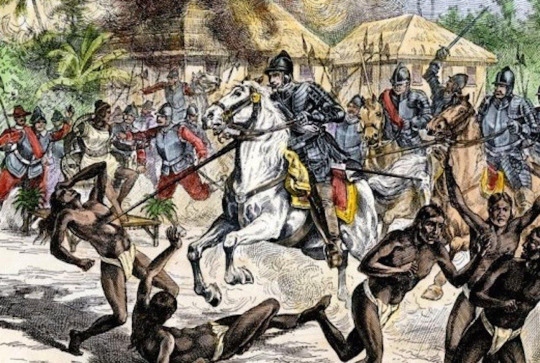

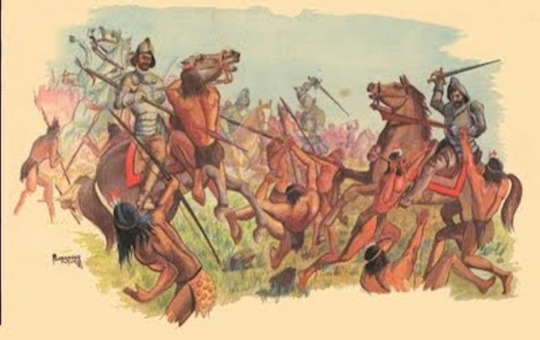







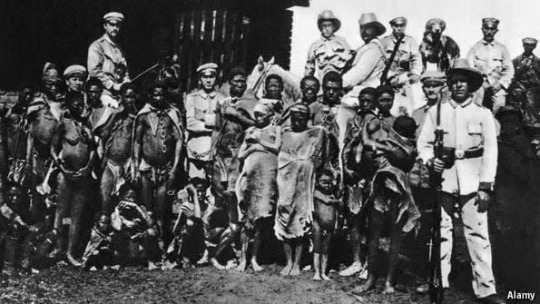


Palestine will be free.
Who Remembers the Armenians?, Najwan Darwish / Myth of the Vanishing Indian, Rena Priest / Shadow Procession, William Kentridge / The Wretched of the Earth, Frantz Fanon / Darfur (Jesus Wept), William F. DeVault / Srebrenica, Safet Zec
#web weave#web weaving#webweaving#palestine#israel#israel palestine conflict#palestinians#gaza#middle east#crusades#armenia#armenian genocide#bosnian genocide#native american#native genocide#the black war#black war#massacre of salsipuedes#moriori genocide#herero and namaqua genocide#herero#namaqua#poetry#poems#colonialism#colonization
301 notes
·
View notes
Text
yes, we shouldn't ignore the terrible events going on right now (Palestine, Sudan, etc), but I think we need some reminders because some of the posts i've been reading have been giving off *extremely* guilt-trippy vibes:
Not posting about current events or bad things =/= not caring.
Not reblogging =/= not caring.
Adding "don't scroll past this" or "reblog this or block me" to posts is guilt-trippy as hell.
And lastly, online activism is not the only form of activism.
#palestine#free palestine#sudan#armenia#ukraine#russo ukrainian war#yemen#congo#just some of what came to mind#sorry but those “i dont get why everyones posting about good things while this bad thing is happening” posts piss me off a lot#because... how do you know they're unaware of the bad events?#how do you know they don't care?#maybe they've donated to pro-palestinian organizations or went to pro-palestine rallies#maybe they're currently checking on their armenian and yemeni friends#i could go on#i am sorry but not everyone has to make a social media post in order to be an activist#in fact i feel like posting about it isn't making a direct difference (and it does come off as preformative)#donating and calling senators and joining protests and boycotts make much bigger differences then posting on social media imo#guilt tripping will be blocked immediately#consider this post a checkpoint in a way#EDIT 4.0: reblogs are back on again.
371 notes
·
View notes
Text
Dedicating Faiz Ahmed Faiz's poem to all the oppressed people throughout the world,specially Palestinians.
A few more days, my love, only a few days more
It is our lot to live under the shadow of tyranny
To suffer this outrage, to bear this pain, to weep awhile
This legacy of our past is our cross to bear
Our bodies are confined, our emotions in shackles
Worry is a prisoner, Speech is proscribed
But there’s a courage within us that keeps us going
It’s as if our very life is a beggar's garment
That needs to be patched with pain, time after time
But now these cruel times have almost run their course
This impatient longing is almost over
In this burnt desolation that is the world and its time
We have to go on, but not this way
The unbearable torment of unseen hands
The futility of heartburn, the body's unheard lament
Has to be endured for now, but not forever
This dust of sorrow that veils your beauty
This bounty of defeats on our fleeting youth
This worthless throbbing under moonlit nights
A few more days, my love, only a few days more
#faiz ahmed faiz#poet of the oppressed#Palestinians#english translation#Chand roz meri jaan faqat chand hi roz#armenians#palestine#israel#usa#iraq#syria#sudan#congo#free congo#free gaza#desiblr#desi tumblr#desi aesthetic#urdu lines#urdu poetry#desi academia#urdu literature#urdu shayari#urdu aesthetic#urdu stuff
97 notes
·
View notes
Text

#leftism#anarchy#eu politics#global politics#world politics#politics#progressive politics#palestinian genocide#stop the genocide#settler colonialism#war crimes#hebron#nakba#ethnic cleansing#genocide#this is genocide#armenian genocide#settler violence#israeli settlers#early settler
70 notes
·
View notes
Text



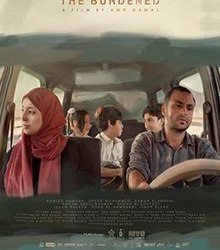






Some 2023 Films by SWANA Filmmakers
The Persian Version. Dir. Maryam Keshavarz (Iranian)
Totally Killer. Dir. Nahnatchka Khan (Iranian)
Bye Bye Tiberias. Dir. Lina Soualem (Palestinian)
The Burderned. Dir. Amr Gamal (Yemeni)
The Mother Of All Lies. Dir. Asmae El Moudir (Moroccan)
Leave The World Behind. Dir. Sam Esmail (Egyptian)
Amerikatsi. Dir. Michael A. Goorjian (Armenian)
Fremont. Dir. Babak Jalali (Iranian/Afghan)
Four Daughters. Dir. Kaouther Ben Hania (Tunisian)
Last Call For Istanbul. Dir. Gönenç Uyanık (Turkish)
#leave the world behind#totally killer#the persian version#fremont#film#bye bye tiberias#the burderned#the mother of all lies#last call for istanbul#four daughters#amerikatsi#iranian#palestinian#yemeni#turkish#tunisian#egyptian#moroccan#afghan#armenian
92 notes
·
View notes
Text
it annoys me when people all categorize palestinians as purely arabs. armenian palestinians have contributed greatly to our visual culture and that deserves to be recognized. just wanted to point out that not all palestinians are arabs, though a majority are. but that might be going too deep into the woodworks of semantics for this point in time. maybe we will find a word that better encompasses the diversity of palestinians — wait. that's it. palestinians is diverse enough, isn't it?
#this is just a diary entry at this point#not gonna make it rebloggable#just wanted to point our palestinians in palestine are quite diverse#i mention armenian palestinians contributing to our collective culture because its important to point it out#not that you need to contribute to a culture to be part of it necessarily
54 notes
·
View notes
Text

By Najwan Darwish, Palestinian Poet
#Najwan Darwish#palestine#Armenia#Palestinian#armenian#west asia#west asian#indigenous west asian#Middle East#Palestinian poetry#palestinian literature#freepalestine#freeartsakh#Artsakh
4K notes
·
View notes
Text
To see all these Western Christian churches celebrate Easter while staying silent about the g3n0c1d3 in Gaza, and the extreme violence against Palestinians of all religions in the West Bank, including Armenian and Palestinians Christians, whose presence is Palestine is at least 1,500 years old, are examples of how Western Christianity is imperialist and colonial.
In some cases, these Western Christian churches are even aiding the g3nocid3.
#genocide in gaza#free gaza#gaza genocide#palestine#palestinians#palestinian christians#armenian christians#jerusalem#easter
34 notes
·
View notes
Text
Not so friendly reminder that Tankies are people who deny not only the genocides of Russia but also Vietnam and China (including the Uyghurs), and are apologists for the North Korean regime. They push Russian propaganda of "colour revolutions" every time a Global South country rises up against a totalitarian government because they believe totalitarianism is merely anti-communist agenda; deriding, dismissing and dehumanizing the liberation movements of our countries that come at great human cost. They're not anti-imperialists or anti-colonial; their chief issue with the imperial core is that it's not their ideology seated at the heart of it. They only care about Global South lives when it serves their ideology, and have no genuine concern or curiosity about the ground realities or agency of the communities impacted by imperialism and colonialism.
I also want you to understand that every major power player involved in this conflict is a genocidal fascist. Hamas, Hezbollah and Houthis that are fighting Israel are funded by the theocratic Iranian regime headed by Ebrahim Raisi (begging you to remember the hundreds of Iranian girls and women killed for protesting it). Iran is also an ally of the notorious Bashar Al-Assad's regime in Syria, responsible for the genocide and displacement of millions of his own people while actively funding the Islamic State he wages war against. Both Assad and Raisi are allies of Putin, who is currently trying to colonize and genocide Ukraine and is terrorising Poland, Hungary, Georgia, Estonia, Latvia etc. However, Iran and Putin (half-heartedly) are also allies of the Armenians who are being genocided by Azerbaijan. Azerbaijan is supported by the US, but also Erdogan in Turkey, infamous dictator that hates the European Union and is a close pal of Putin. Meanwhile the US's best friends in the Middle East is Israel, which hates Arabs, and Saudi Arabia, who doesn't recognise Israel as a country but is hated by most of the MENA and is currently in a Cold War with Iran.
*yanks y'all by the shirt and shouts in your face* THERE ARE NO GOOD GUYS HERE, DO YOU UNDERSTAND?? ONLY INNOCENT CIVILIANS CAUGHT IN A SPIDER WEB OF GREEDY, DESPOTIC, GENOCIDAL, FASCIST CUNTS. THERE IS NO POINT TRYING TO FIGURE OUT WHICH ONE IS THE BIGGEST THREAT TO GLOBAL DEMOCRACY BECAUSE ALL THE FALL OF ONE DOES IS CREATE A POWER VACCUUM THAT WILL IMMEDIATELY BE FILLED BY THE NEXT BULLY.
These governments can only be toppled from within by their own people once external threats like war with their neighbours are eased, because militaries with nothing to fight are economic black holes that try to eat itself, and it's this economic stress that act as catalysts for coalition building and civilian revolt. Military losses weaken imperialists' coercive power and legitimacy over their own people, so the best thing you can do to help them agitate for change is preventing imperialist expansions from claiming any more victims.
#TL;DR: if the US divests from Israel#withdraws entirely from Iraq and Syria and actually commits to helping Ukraine beat back Putin#it would break Israel's continuing destabilising of the Middle East#and consequent lessening of external threat might lessen some of these states' chokeholds over their own people.#Sadly‚ it's also why the US refuses to do so. Ukraine means little to the US#while the MENA keeps the US's arms and oil industries in business.#If Putin invades Ukraine and the US is tied up fighting seven different countries in the Middle East alongside Israel#he's going to try and encroach into Poland#and then we're on the brink of nuclear war.#Althoug actually we might not have to wait that long#considering the US is already aiming nuclear missiles at Iran for being mean to Israel#and also attacking the US's bases in Iraq and Syria in retaliation for Gaza.#tankies#war in ukraine#ukrainian genocide#palestinian genocide#armenian genocide#western leftists#geo-politics#decolonisation#colonization#imperialism#middle east#global south#totalitarianism#western propaganda#western imperialism#genocide denial#liberation#knee of huss
43 notes
·
View notes
Text
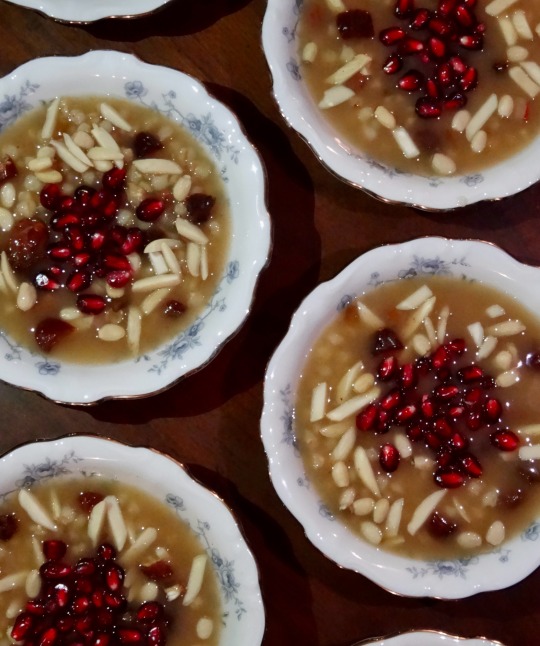
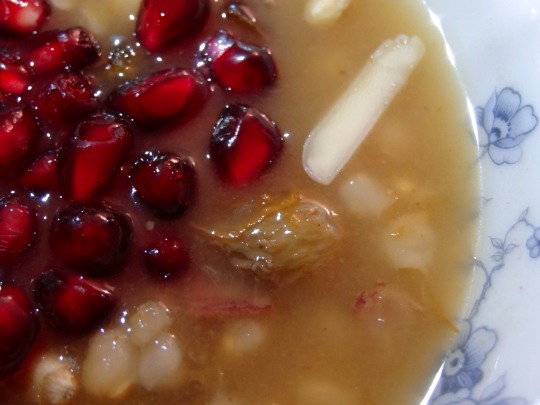
[ID: First image shows four small porcelain bowls of a pudding topped with slivered almonds and pomegranates seeds, seen from above. Second image is an extreme close-up showing the blue floral pattern on the china, slivered almonds, golden raisins, and pomegranate seeds on top of part of the pudding. End ID]
անուշապուր / Anush apur (Armenian wheat dessert)
Anush apur is a sweet boiled wheat pudding, enriched with nuts and dried fruits, that is eaten by Armenians to celebrate special occasions. One legend associates the dish with Noah's Ark: standing on Mt. Ararat (Արարատ լեռը) and seeing the rainbow of God's covenant with humanity, Noah wished to celebrate, and called for a stew to be prepared; because the Ark's stores were diminishing, the stew had to be made with small amounts of many different ingredients.
The consumption of boiled grains is of ancient origin throughout the Levant and elsewhere in West Asia, and so variations of this dish are widespread. The Armenian term is from "անուշ" ("anush") "sweet" + "ապուր" ("apur") "soup," but closely related dishes (or, arguably, versions of the same dish) have many different, overlapping names.
In Arabic, an enriched wheat pudding may be known as "سْنَينِيّة" ("snaynīyya"), presumably from "سِنّ" "sinn" "tooth" and related to the tradition of serving it on the occasion of an infant's teething; "قَمْح مَسْلُوق" ("qamḥ masluq"), "boiled wheat"; or "سَلِيقَة" ("salīqa") or "سَلِيقَة القَمْح" ("salīqa al-qamḥ"), "stew" or "wheat stew," from "سَلَقَ" "salaqa" "to boil." Though these dishes are often related to celebrations and happy occasions, in some places they retain an ancient association with death and funerary rites: qamh masluq is often served at funerals in the Christian town of بَيْت جَالَا ("bayt jālā," Beit Jala, near Bethlehem).
A Lebanese iteration, often made with milk rather than water, is known as "قَمْحِيَّة" ("qamḥīyya," from "qamḥ" "wheat" + "ـِيَّة" "iyya," noun suffix).
A similar dish is known as "بُرْبَارَة" ("burbāra") by Palestinian and Jordanian Christians when eaten to celebrate the feast of Saint Barbara, which falls on the 4th of December (compare Greek "βαρβάρα" "varvára"). It may be garnished with sugar-coated chickpeas and small, brightly colored fennel candies in addition to the expected dried fruits and nuts.
In Turkish it is "aşure," from the Arabic "عَاشُوْرَاء" ("'āshūrā"), itself from "عَاشِر" ("'āshir") "tenth"—because it is often served on the tenth day of the month of ٱلْمُحَرَّم ("muḥarram"), to commemorate Gabriel's teaching Adam and Eve how to farm wheat; Noah's disembarkment from the Ark; Moses' parting of the Red Sea; and the killing of the prophet الْحُسَيْن بْنِ عَلِي (Husayn ibn 'Ali), all of which took place on this day in the Islamic calendar. Here it also includes various types of beans and chickpeas. There is also "diş buğdayı," "tooth wheat" (compare "snayniyya").
These dishes, as well as slight variations in add-ins, have varying consistencies. At one extreme, koliva (Greek: "κόλλυβα"; Serbian: "Кољиво"; Bulgarian: "Кутя"; Romanian: "colivă"; Georgian: "კოლიო") is made from wheat that has been boiled and then strained to remove the boiling water; at the other, Armenian anush apur is usually made thin, and cools to a jelly-like consistency.
Anush apur is eaten to celebrate occasions including New Year's Eve, Easter, and Christmas. In Palestine, Christmas is celebrated by members of the Armenian Apostolic church from the evening of December 24th to the day of December 25th by the old Julian calendar (January 6th–7th, according to the new Gregorian calendar); Armenian Catholics celebrate on December 24th and 25th by the Gregorian calendar. Families will make large batches of anush apur and exchange bowls with their neighbors and friends.
The history of Armenians in Palestine is deeply interwoven with the history of Palestinian Christianity. Armenian Christian pilgrimages to holy sites in Palestine date back to the 4th century A.D., and permanent Armenian monastic communities have existed in Jerusalem since the 6th century. This enduring presence, bolstered by subsequent waves of immigration which have increased and changed the character of the Armenian population in Palestine in the intervening centuries, has produced a rich history of mutual influence between Armenian and Palestinian food cultures.
In the centuries following the establishment of the monasteries, communities of Armenian laypeople arose and grew, centered around Jerusalem's Վանք Հայոց Սրբոց Յակոբեանց ("vank hayots surbots yakobeants"; Monastery of St. James) (Arabic: دَيْر مَار يَعْقُوب "dayr mār ya'qūb"). Some of these laypeople were descended from the earlier pilgrims. By the end of the 11th century, what is now called the Armenian Quarter—an area covering about a sixth of the Old City of Jerusalem, to the southwest—had largely attained its present boundaries.
Throughout the 16th and 17th centuries, the Patriarchate in Jerusalem came to have direct administrative authority over Armenian Christians across Palestine, Lebanon, Egypt, and Cyprus, and was an important figure in Christian leadership and management of holy sites in Jerusalem (alongside the Greek Orthodox and Roman Catholic churches). By the middle of the 19th century, a small population of Armenian Catholics had joined the larger Armenian Apostolic community as permanent residents in Jerusalem, living throughout the Muslim Quarter (but mostly in a concentrated enclave in the southwest); in the beginning of the 20th century, there were between 2,000 and 3,000 Armenians of both churches in Palestine, a plurality of whom (1,200) lived in Jerusalem.
The Turkish genocide of Armenians beginning in 1915 caused significant increases in the populations of Armenian enclaves in Palestine. The Armenian population in Jerusalem grew from 1,500 to 5,000 between the years of 1918 and 1922; over the next 3 years, the total number of Armenians in Palestine (according to Patriarchate data) would grow to 15,000. More than 800 children were taken into Armenian orphanages in Jerusalem; students from the destroyed Չարխափան Սուրբ Աստվածածին վանք (Charkhapan Surb Astvatsatsin Monastery) and theological seminary in Armash, Armenia were brought to the Jerusalem Seminary. The population of Armenian Catholics in the Muslim Quarter also increased during the first half of the 20th century as immigrants from Cilicia and elsewhere arrived.
The immediate importance of feeding and housing the refugees despite a new lack of donations from Armenian pilgrims, who had stopped coming during WW1—as well as the fact that the established Armenian-Palestinians were now outnumbered by recent immigrants who largely did not share their reformist views—disrupted efforts on the part of lay communities and some priests to give Armenian laypeople a say in church governance.
The British Mandate, under which Britain assumed political and military control of Palestine from 1923–1948, would further decrease the Armenian lay community's voice in Jerusalem (removing, for example, their say in elections of new church Patriarchs). The British knew that the indigenous population would be easier to control if they were politically and socially divided into their separate religious groups and subjected to the authority of their various religious hierarchies, rather than having direct political representation in government; they also took advantage of the fact that the ecclesiastical orders of several Palestinian Christian sects (including the Armenian Patriarchate of Jerusalem) comprised people from outside of Palestine, who identified with religious hierarchy and the British authorities more than they identified with the Palestinian lay communities.
British policy, as well as alienating Armenians from politics affecting their communities, isolated them from Arab Palestinians. Though the previously extant Armenian community (called "քաղաքացի" "kaghakatsi," "city-dwellers") were thoroughly integrated with the Arab Palestinians in the 1920s, speaking Arabic and Arabic-accented Armenian and eating Palestinian foods, the newer arrivals (called "زُوَّار" / "զուվվար" "zuwwar," "visitors") were unfamiliar with Palestinian cuisine and customs, and spoke only Armenian and/or Turkish. Thus British policies, which differentiated people based on status as "Arab" (Muslim and Christian) versus "Jewish," left new Armenian immigrants, who did not identify as Arab, disconnected from the issues that concerned most Palestinians. They were predominantly interested in preserving Armenian culture, and more concerned with the politics of the Armenian diaspora than with local ones.
Despite these challenges, the Armenian Patriarchate of Jerusalem came to be a vital center of religious and secular culture for the Armenian diaspora during the British Mandate years. In 1929, Patriarch Yeghishe Turian reëstablished the Սուրբ Յակոբեանց Տպարան ("surbots yakobeants taparan"; St. James printing house); the Patriarchate housed important archives relating to the history of the Armenian people; pilgrimages of Armenians from Syria, Lebanon, and Egypt increased and the economy improved, attracting Armenian immigrants in higher numbers; Armenians held secular roles in governance, policing, and business, and founded social, religious, and educational organizations and institutions; Armenians in the Old and New Cities of Jerusalem were able to send financial aid to Armenian victims of a 1933 earthquake in Beirut, and to Armenians expelled in 1939 when Turkey annexed Alexandretta.
The situation would decline rapidly after the 1947 UN partition resolution gave Zionists tacit permission to expel Palestinians from broad swathes of Palestine. Jerusalem, intended by the plan to be a "corpus separatum" under international administration, was in fact subjected to a months-long war that ended with its being divided into western (Israeli) and eastern (Palestinian) sections. The Armenian population of Palestine began to decline; already, 1947 saw 1,500 Armenians resettled in Soviet Armenia. The Armenian populations in Yafa and Haifa would fall yet more significantly.
Still, the Armenian Patriarchate of Jerusalem maintained its role as the center of Armenian life in Palestine; the compound provided food and shelter to thousands of Armenians during the Battle for Jerusalem and the Nakba (which began in 1948). Some Armenians formed a militia to defend the Armenian Quarter against Haganah shelling during the battle.
In the following years, historical British contributions to the shoring up of insular power in the Patriarchate would cause new problems. The Armenian secular community, no longer empowered to oversee the internal workings of the Patriarchate, could do nothing to prevent embezzling, corruption, and even the sale of church-owned land and buildings to settlers.
In 1967, Israeli military forces annexed East Jerusalem, causing another, albeit smaller, surge in Armenian emigration from the city. Daphne Tsimhoni estimates based on various censuses that the Armenian population of Jerusalem, which had reached 5,000-7,000 at its peak in 1945–6, had fallen back to 1,200 by 1978.
Today, as in the 20th century, Armenians in Jerusalem (who made up nearly 90% of the Armenian population of Palestine as of 1972) are known for the insularity of their community, and for their skill at various crafts. Armenian food culture has been kept alive and well-defined by successive waves of immigrants. As of 2017, the Armenian Patriarchate supplied about 120 people a day with Armenian dishes, including Ղափամա / غاباما "ghapama" (pumpkin stuffed with rice and dried fruits), թոփիկ / توبيك "topig" (chickpea-and-potato dough stuffed with an onion, nut, fruit, and herb filling, often eaten during Lent), and Իչ / ايتش "eetch" (bulgur salad with tomatoes and herbs).
Restaurants lining the streets of the Armenian and Christian quarters serve a mixture of Armenian and Palestinian food. Լահմաջո "lahmadjoun" (meat-topped flatbread), and հարիսա / هريس "harisa" (stew with wheat and lamb) are served alongside ֆալաֆել / فلافل ("falafel") and մուսախան / مسخن ("musakhkhan"). One such restaurant, Taboon Wine Bar, was the site of a settler attack on Armenian diners in January 2023.
Up until 2023, despite fluctuations in population, the Armenian community in Jerusalem had been relatively stable when compared to other Armenian communities and to other quarters of the Old City; the Armenian Quarter had not been subjected to the development projects to which other quarters had been subjected. However, a deal which the Armenian Patriarchate had secretly and unilaterally made with Israel real estate developer Danny Rotham in 2021 to lease land and buildings (including family homes) in the Quarter led Jordan and Palestine to suspend their recognition of the Patriarch in May of 2023.
On 26th October, the Patriarchate announced that it was cancelling the leasing deal. Later the same day, Israeli bulldozers tore up pavement and part of a wall in حديقة البقر ("ḥadīqa al-baqar"; Cows' Garden; Armenian: "Կովերի այգու"), the planned site of a new luxury hotel. On 5th November, Rothman and other representatives of Xana Gardens arrived with 15 settlers—some of them with guns and attack dogs—and told local Armenians to leave. About 200 Armenian Palestinians arrived and forced the settlers to stand down.
On 12th and 13th November, the developer again arrived with bulldozers and attempted to continue demolition. In response, Armenian Palestinians have executed constant sit-ins, faced off against bulldozers, and set up barricades to prevent further destruction. The Israeli occupation police backed settlers on another incursion on 15th November, ordering Armenian residents to vacate the land and arresting three.
On December 28th, a group of Armenian bishops, priests, deacons, and seminary students (including Bishop Koryoun Baghdasaryan, the director of the Patriarchate's real estate department) were attacked by a group of more than 30 people armed with sticks and tear gas. The Patriarchate attributed this attack to Israeli real estate interests trying to intimidate the Patriarchate into abandoning their attempt to reverse the lease through the court system. Meanwhile, anti-Armenian hate crimes (including spitting on priests) had noticeably increased for the year of 2023.
These events in Palestine come immediately after the ethnic cleansing of Լեռնային Ղարաբաղ ("Lernayin Gharabagh"; Nagorno-Karabakh); Israel supplied exploding drones, long-range missiles, and rocket launchers to help Azerbaijan force nearly 120,000 Armenians out of the historically Armenian territory in September of 2023 (Azerbaijan receives about 70% of its weapons from Israel, and supplies about 40% of Israel's oil).
Support Palestinian resistance by donating to Palestine Action’s bail fund; buying an e-sim for distribution in Gaza; or donating to help a family leave Gaza.
Ingredients
180g (1 cup) pearled wheat (قمح مقشور / խոշոր ձաւար), soaked overnight
3 cups water
180-360g (a scant cup - 1 3/4 cup) sugar, or to taste
Honey or agave nectar (optional)
1 cup total diced dried apricots, prunes, golden raisins, dried figs
1 cup total chopped walnuts, almonds, pistachios
1 tsp rosewater (optional)
Ceylon cinnamon (դարչին) or cassia cinnamon (կասիա)
Aniseed (անիսոն) (optional)
Large pinch of salt
Pomegranate seeds, to top (optional)
A Palestinian version of this dish may add pine nuts and ground fennel.
Pearled wheat is whole wheat berry that has gone through a "pearling" process to remove the bran. It can be found sold as "pearled wheat" or "haleem wheat" in a halal grocery store, or a store specializing in South Asian produce.
Amounts of sugar called for in Armenian recipes range from none (honey is stirred into the dish after cooking) to twice the amount of wheat by weight. If you want to add less sugar than is called for here, cook down to a thicker consistency than called for (as the sugar will not be able to thicken the pudding as much).
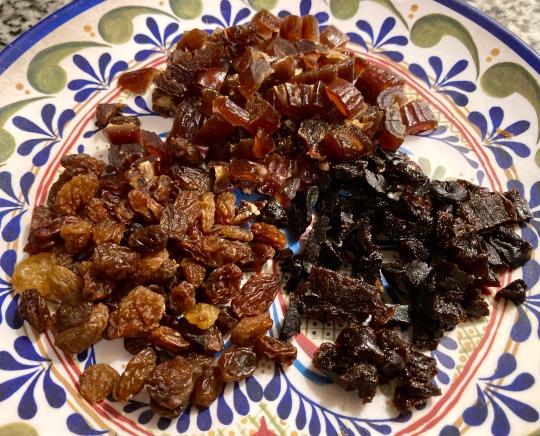
Instructions
1. Submerge wheat in water and scrub between your hands to clean and remove excess starch. Drain and cover by a couple inches with hot water. Cover and leave overnight.
2. Drain wheat and add to a large pot. Add water to cover and simmer for about 30 minutes until softened, stirring and adding more hot water as necessary.

Wheat before cooking
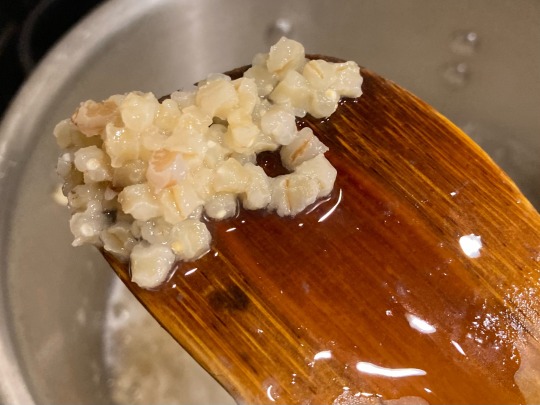
Wheat after cooking
3. Add dried fruit, sugar, salt, and spices and simmer for another 30 minutes, stirring occasionally, until wheat is very tender. Add water as necessary; the pudding should be relatively thin, but still able to coat the back of a spoon.
4. Remove from heat and stir in rosewater and honey. Ladle pudding into individual serving bowls and let cool in the refrigerator. Serve cold decorated with nuts and pomegranate seeds.
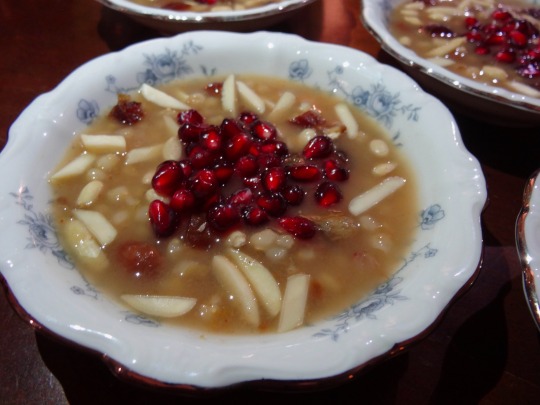
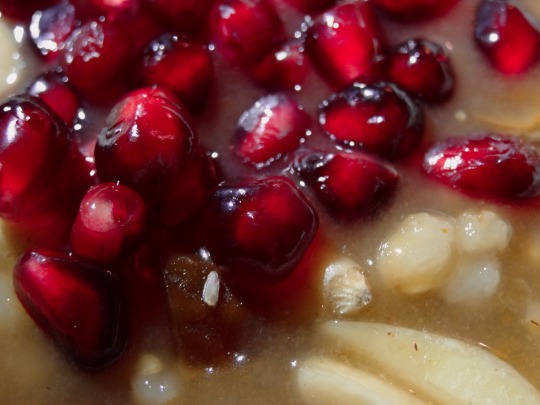
#the last link is a different / new fundraiser#Armenian#Palestinian#fusion#wheat berries#pearled wheats#pomegranate#prunes#dried apricot#dates#long post /
364 notes
·
View notes
Text
when people say "use your privilege" they don't mean use your privilege of distance to not speak on situations.
I'm seeing so many blogs not talk about the current attempts of Palestinian genocide (probably because they want to "keep their blog aesthetic") and I'm seeing barely anyone talk about the world wide rise in antisemitism or the current Armenian genocide
But I guess all that means for you is that pretty soon you might have to pretend to care about another ethnic group being wiped out* - must be hard /s
*until it stops being trendy...
BLM
StopAsianhate
Missing And Murdered Indigenous Women
Stand With Ukraine
Yemen
Iraq
Syria
#free palestine#hamas is isis#antisemitism#nagorno karabakh#armenian genocide#israel#hamas massacre#alestinian genocide#gaza strip#ukraine#stand with ukraine#iraq war#iraq invasion#syria#yemen war#yemen#syrian refugees#palestinian genocide#antisemitsm tw
35 notes
·
View notes